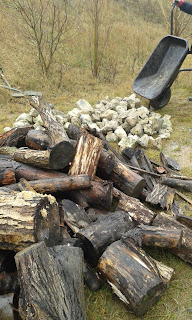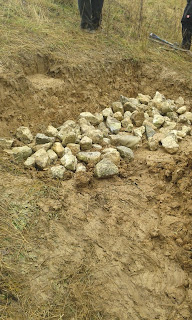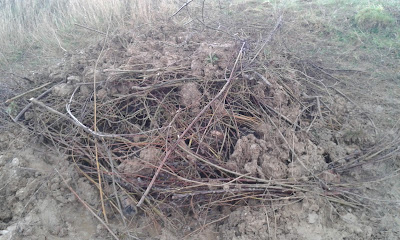Yesterday whilst volunteering at my local
Lee Valley Park, I assisted with the creation of a new hibernacula for reptiles. The word hibernacula comes from the
Latin phrase meaning, "tent for winter quarters" but these refuges may be utilised all year round, perhaps even just as a wildlife corridor.
With a little planning, you can easily create hibernacula and refugia in your own garden which can make a big difference by
providing extra food and refuge for reptiles and compensating for the loss of appropriate habitats in surrounding areas and creating secure passages through the landscape.
There are a variety of materials you can use. Tree roots, deep leave litter, compost heaps, log piles and rock piles
are locations that can be great refuges and hibernacula for reptiles as well as amphibians - providing habitat, cover,
locations to bask, and food.
You can find out if reptiles are using your garden by leaving out spare wooden boards, roofing felt or carpet tiles, which may be used
for basking or taking refuge underneath.
 Stage 1 - Location
Stage 1 - Location
Preferably you should plan where you want to put your hibernacula first, as it could involve digging an area to put your materials. The most important thing to remember here is drainage, you don't want to dig a hole in the ground as though you would a pond, as it will just collect water and won't be fit for purpose.
Also avoid using straight sides and edges, a sloped pit will be much better for draining away water. Our hibernacula yesterday was dug into the side of a small hill not too far from some hedgerows and trees.
Stage 2 - Placing your materials


After you have dug out the area for your hibernacula, the best first layer will be rocks and stones. These should be placed around the bottom area to create your base and should have gaps inbetween when piling them on top of each other. Remember that you aren't trying to make it inpenetrable! If you don't have rocks or stones, broken up bricks can be used as an alternative.
After the stones are placed, logs, sticks and branches are a good next
layer. As before, be careful not to create an inpenetrable pile of wood,
be sure to put the logs at different angles on top of each other to
allow spaces and gaps inbetween. Don't worry if you have limited
materials available to you, anything natural will do. You can use wood,
tree roots, rubble, compost, mulch etc. Mix up your materials in a
natural way and avoid being too tidy, a messy design with varying
shapes, levels and gaps is exactly what you want.
 Stage 3 - Cover
Stage 3 - Cover
Finally, you should cover the top of your hibernacula with any suitable vegetation but ideally from the same
location or area. A natural grass and
bramble mix works well, this is similar to what we used for ours (shown to the right). Due to the location, we had plenty of surrounding vegetation on the hill that will grow around the refuge and set it in. If you are creating one in your garden, then planting or relocating suitable scrub on the northern side can also provide extra cover and shade, especially if your refuge doesn't have many plants or trees around it that are naturally occurring. You can place any soil or mud that you dug out previously on top of the refuge, this can help to protect it.
Remember: If you believe reptiles or amphibians may already be using your garden and the site is overgrown and you need to strim the area beforehand or carry out maintenance and gather materials, do a careful
search to check for animals before you start in the area and proceed with caution. If the
area you are creating your refuge on is a sensitive reptile site, or maybe Great Crested Newts could be
present, contact a herpetologist or an organisation such as
FrogLife, who will be able to advise and assist you.
 |
| Our completed hibernacula at Lee Valley. |
Depending on your location you may likely see Slow-worms and Grass Snakes using the refuge. It is rarer to see Adders and Common Lizards, but still possible!
Feel free to comment or message with pictures of your own DIY hibernacula, it'll be great to see how you got on.







